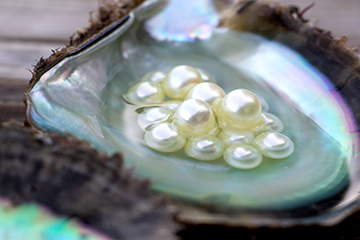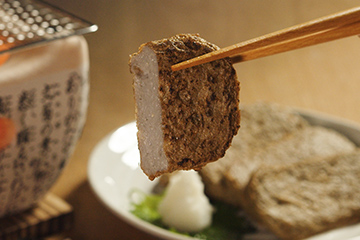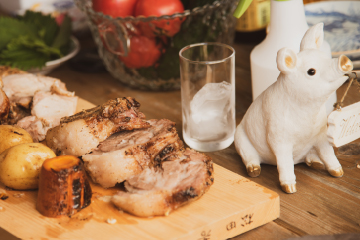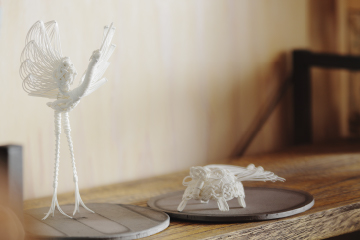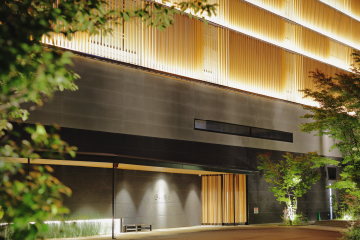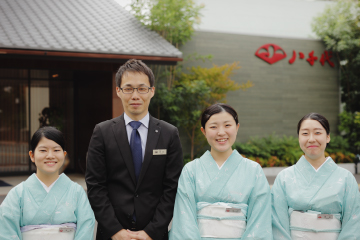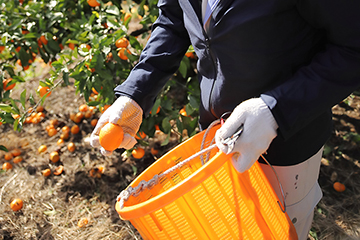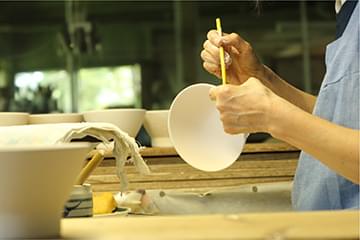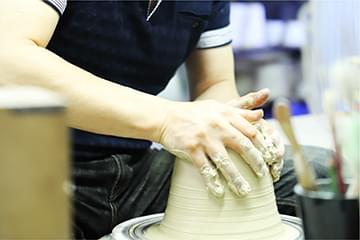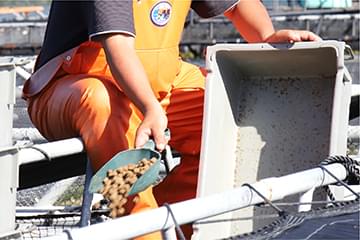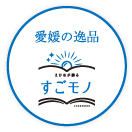“Mizuhiki of Iyo.”
A new form of mizuhiki for modern life.
Everyone in Japan has seen it, but not many know what it’s called. “Mizuhiki” has been produced since ancient times in Ehime Prefecture, which was once known as the country of Iyo, and is one of these hidden gems. Mizuhiki is a paper cord used to wrap gifts and congratulatory bags. For many years, Shikokuchuo’s mizuhiki has supported Japan’s gift-giving culture as one of the leading producers of mizuhiki in Japan, and is designated as a traditional specialty of the prefecture. Now, mizuhiki is taking a leap forward with the techniques it has cultivated over the years, and is beginning to take on innovative challenges that go beyond the traditional framework.

The skills of traditional craftsmen and the sensitivity of artists are fused together.
In February 2020, “MIMUS”, an original brand of Iyo Mizuhiki, held pop-up shops in SPIRAL, Minami Aoyama, Tokyo, and KITTE Marunouchi, which were very popular with female customers. Its products are full of originality and modernity, overturning the traditional image of traditional craftwork, such as “White Mukku”, which is an all-white version of the traditional “Yuino” ornaments made of colorful Mizuhiki, and “Soshina”, which is an accessory made from dead stock Mizuhiki. “The MIMUS was created through a collaboration between Mimusukai, a group of female traditional craftsmen, and Aya Tsukioka, an artist from Matsuyama City. MIMUS was created through a collaboration between the Mimusukai, a group of female traditional crafters, and Aya Tsukioka, an artist from Matsuyama City,” says Tatsuya Ishikawa, chairman of the Iyo Mizuhiki Kinpaku Kyodo Kumiai, a cooperative that supports the group’s activities, and a craftsman with more than 20 years of experience. The high level of skill of the traditional artisan, which only a few people can qualify for, is combined with the sensitivity of up-and-coming artists to create a new type of mizuhiki that blends comfortably with modern lifestyles.

Mr. Tatsuya Ishikawa, Chairman of the Board of Directors of the Iyo Mizuhiki Kinpaku Cooperative Association, of which about 90% of Mizuhiki-related companies in Shikoku Central City are members. Mr. Ishikawa worked for a packaging company for about 20 years, which, like mizuhiki, is in the business of “wrapping” and “decorating”. With the broad perspective and flexible ideas cultivated through this experience, he is making efforts to spread Mizuhiki culture and develop new markets.

The Mimuskai was formed by female mizuhiki artisans, including nine traditional artisans. They are actively involved in educational activities to promote Mizuhiki culture in local schools and companies. It is also a valuable opportunity for traditional artisans working in different workplaces to get together and improve their skills.

Shikokuchuo City, which is blessed with an abundant water source and wood resources, boasts the largest paper production in Japan. It is said to be the birthplace of the “Shugi Bukuro” (ceremonial envelope), and many companies still produce everything from mizuhiki to gold seal.

Any large piece of work is one of a kind, knitted by hand without a blueprint.
All mizuhiki products are made by “knotting”, “weaving” and “wrapping” paper strings of 92 cm each. Sometimes hundreds or even thousands of Mizuhiki are used to make large pieces of work, but even in these cases, no machines are used at all, and all work is done by hand. Hiroko Hoshikawa, a traditional craftswoman, says, “I always select colors from among the said 400 colors of Mizuhiki and devise ways to weave them while moving my fingers. Mizuhiki making is truly a world of artisans without a blueprint or manual. Even if a traditional product has the same motif, it is a one-of-a-kind product that reflects each craftsman’s persistence and individuality.” Ms. Hoshikawa has been making Mizuhiki for more than 40 years, but she still learns regularly from senior craftsmen to further improve her skills.

Hiroko Hoshikawa works at Toyomitsu Hoshikawa Shoten, where her husband, Tsumio Hoshikawa, serves as president. Since its establishment in 1958 as a paper sales company, Toyomitsu has been developing a variety of mizuhiki products to meet the needs of the times.

Hoshikawa Toyomitsu Shoten planned and produced Mizuhiki products featuring “Mikyan” and “Dark Mikyan”, two Ehime Prefecture’s popular characters. The two traditional craftsmen working at the store also produce other unique products, such as seasonal products for Halloween and other seasons and wall decorations that match modern living rooms.

The ability to create any piece of work with a few tools, like those used in arts and crafts classes, is a true testament to the skills of a traditional craftsman.

Mizuhiki, which can beautifully express your thoughts and feelings, has attracted the attention of the younger generation and new markets.

Mizuhiki has become suddenly popular, with participants from all over Japan coming to take the Mizuhiki tying examination sponsored by the Iyo Mizuhiki Kinpaku Cooperative Association. Local elementary and junior high school students have formed the “Mizuhiki Girls” to develop original products, and foreign tourists have chosen souvenirs with Mizuhiki on them. In addition, many Mizuhiki artists, led by the Iyo Mizuhiki Kinpu Cooperative Association, have endorsed the Citrus Ribbon Project, which was launched by volunteers in Ehime Prefecture to eliminate discrimination against people infected with the new corona virus. Many of the artists, mainly from the Iyo Mizuhiki Kinzoku Cooperative Association, have come on board with this project. They have created their logo with Mizuhiki and sent it out on social networking services, and this new Japanese culture from Ehime is making great strides into the world in the future to connect people with each other.

The basis of Mizuhiki is the awaiji knot, which can be used for both celebrations and Buddhist services. You can express your feelings by tying a knot in the right way depending on the occasion, such as tying a knot for a one-time wedding or other celebration, or tying a flower knot for an entrance ceremony.

Mizuhiki is made of paper, and because of its light weight, it is perfect for earrings and other accessories. It can also be used to decorate Western-style products such as New Year’s pastries and jewelry boxes.
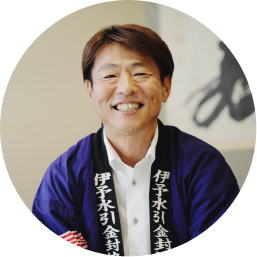 Chairman of the Board of Directors: Mr. Tatsuya Ishikawa
Chairman of the Board of Directors: Mr. Tatsuya IshikawaTel: 0896-56-8441
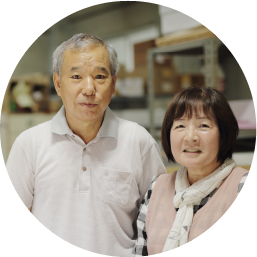 Mr. Tsumio Hoshikawa
Mr. Tsumio HoshikawaMs. Hiroko Hoshikawa
Tel: 0896-56-3256







